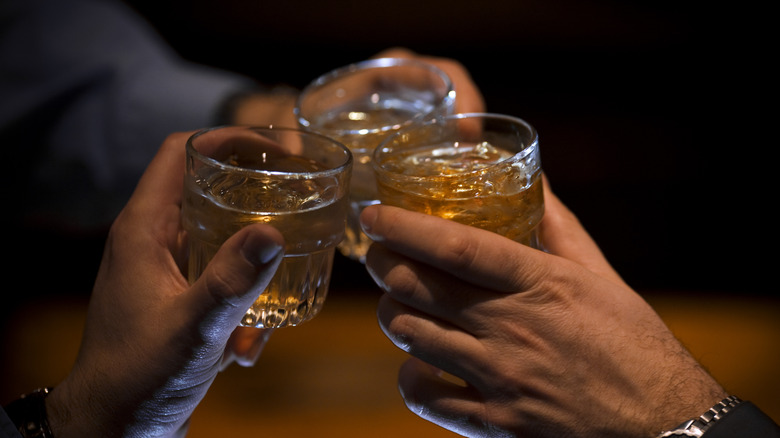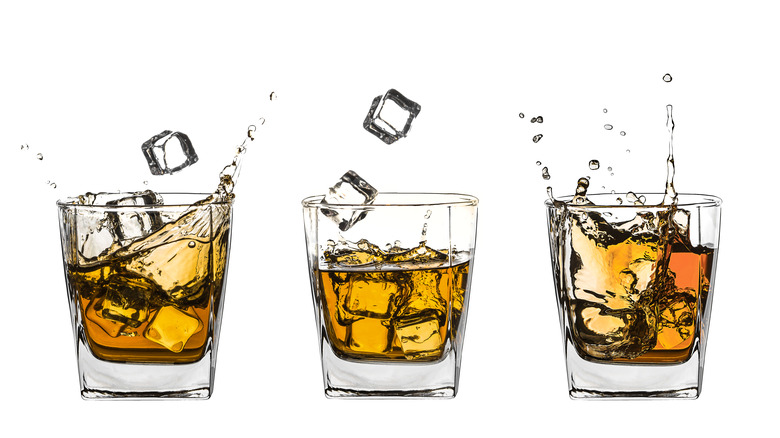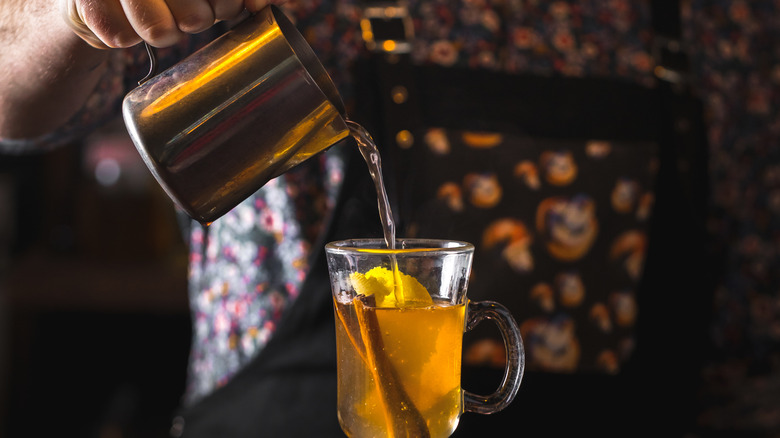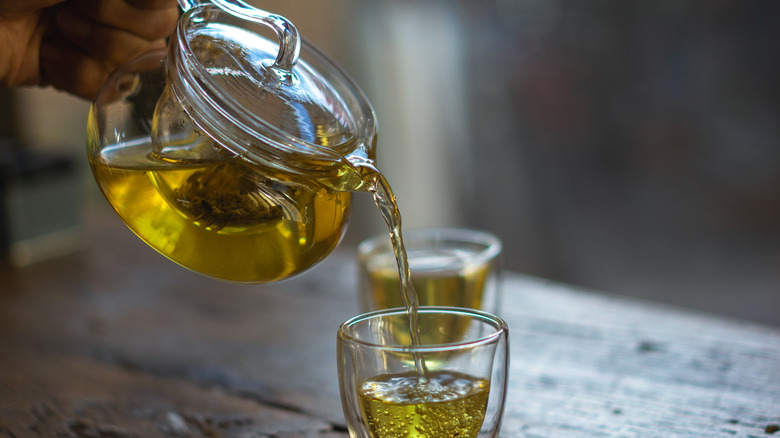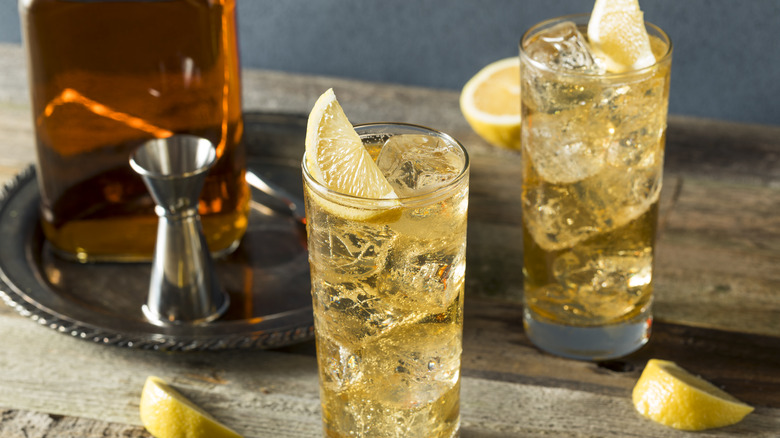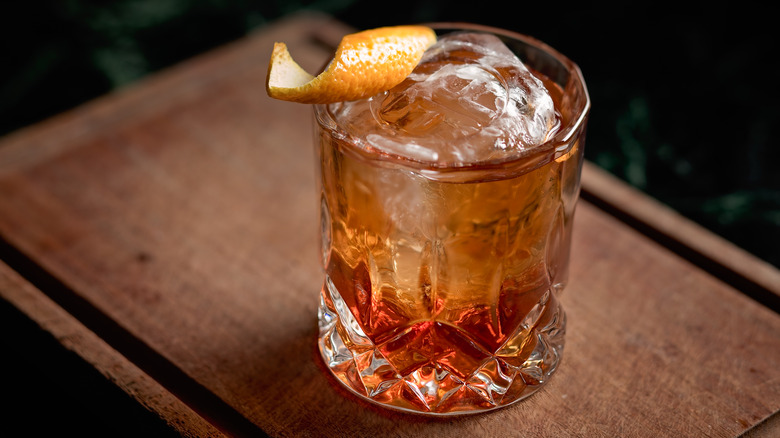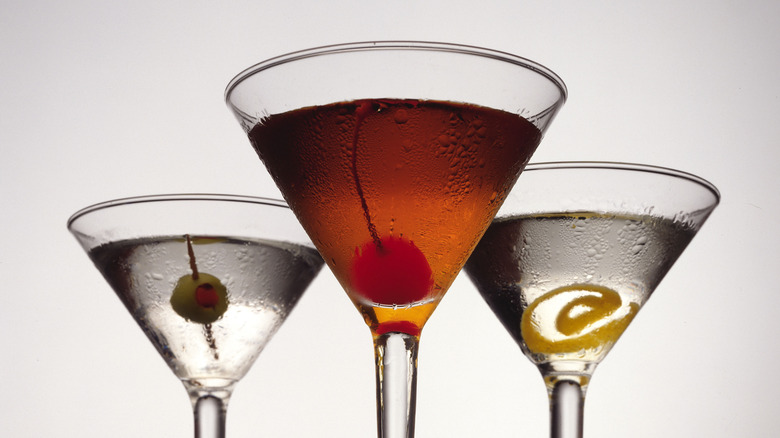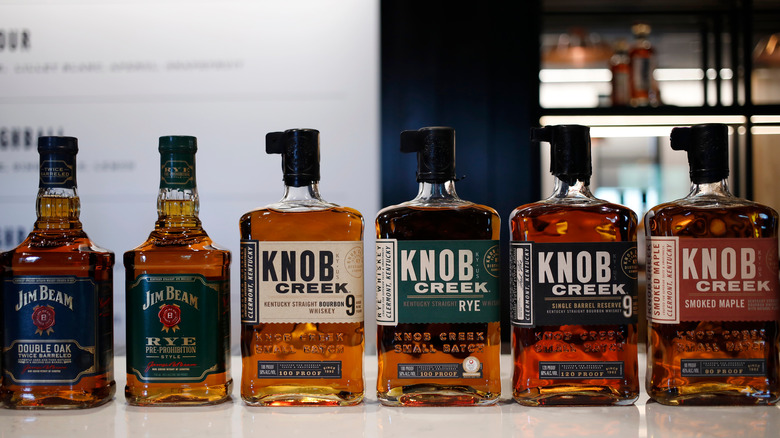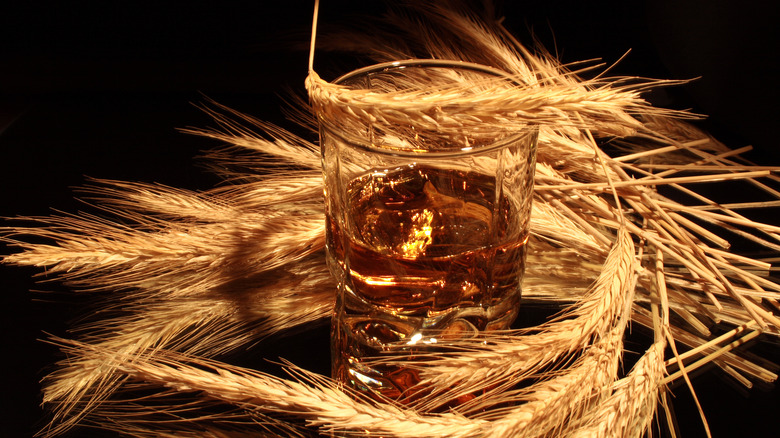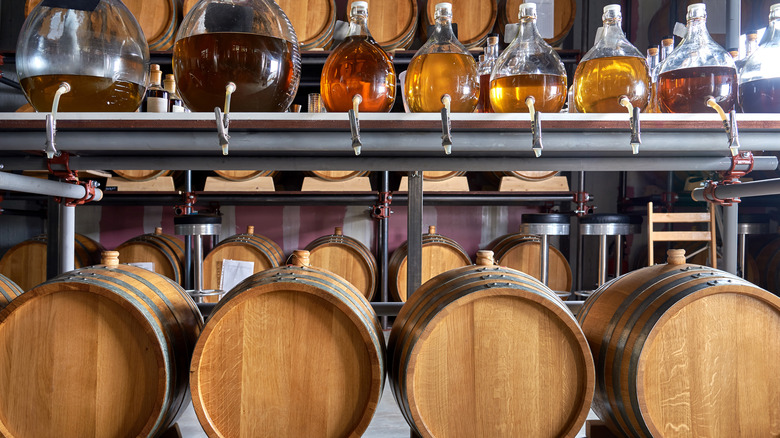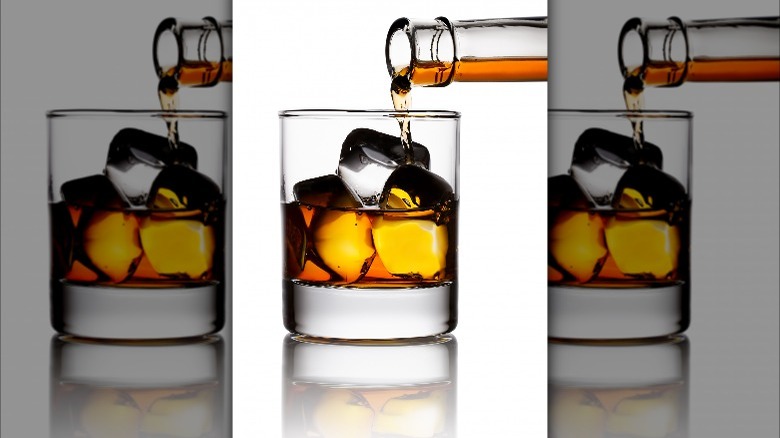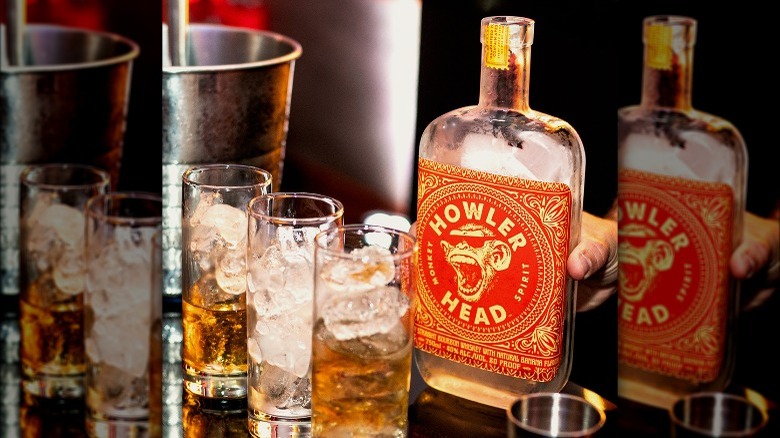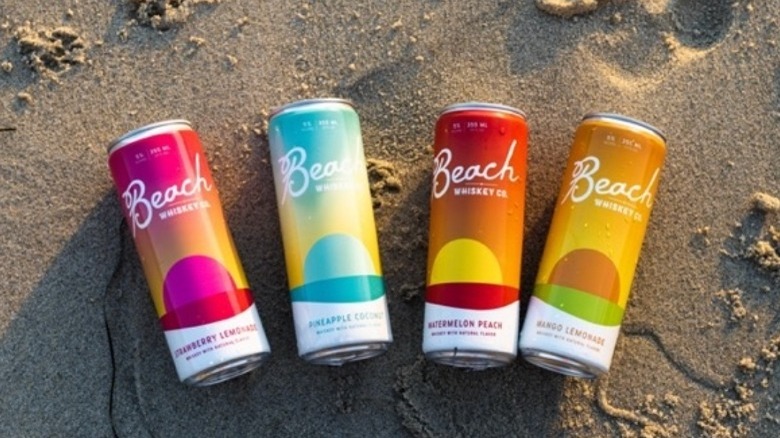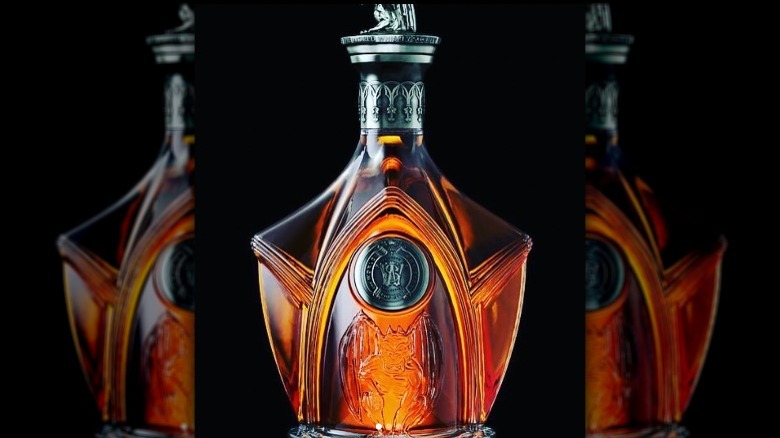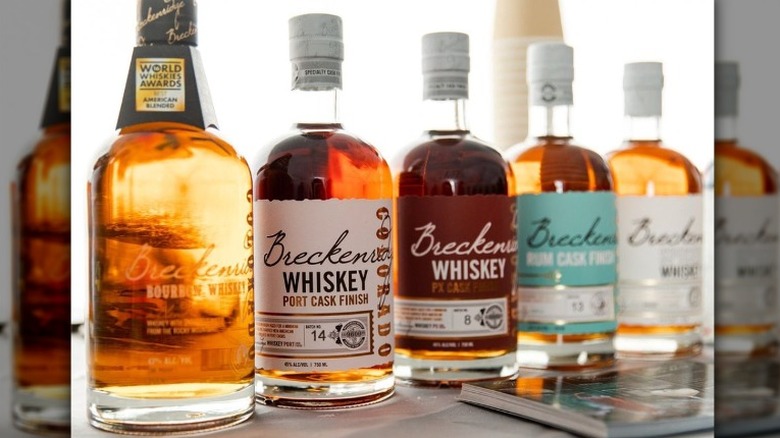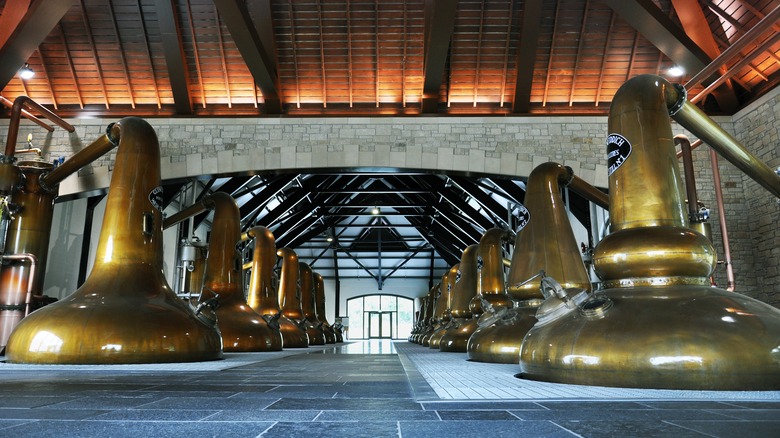15 Unique Ways To Drink Whiskey
For those who can't get enough dark liquor, drinking whiskey is more than just a past-time. Similarly to those with a heightened interest in wine or beer, the world of whiskey is robust and worth exploring. There are so many styles that all fall under the broad category of whiskey that each have a perceptible taste. Additionally, there are plenty of classic cocktails with a whiskey base that has remained bar staples for years.
An interesting aspect of drinking whiskey is that many people enjoy drinking it straight or on the rocks. They find the style they like the best and stick to it, even often having a go-to bottle for their evening nightcap. Any spirits enthusiast shouldn't box themselves into a corner with what they drink for the sole reason that there's almost an endless amount of whiskey expressions that are worthy of trying at least one sip of.
We wanted to help reinvigorate the world of whiskey for those dark-liquor drinkers who have fallen into a rut with their go-to drink. For starters, we came up with 15 unique ways to drink whiskey that are outside of the box. It's a good guide to help anyone, from a novice to an expert, learn a little bit more about one of the world's most beloved spirits.
Adding a dash of water
It might seem like common sense for someone to want to avoid watering down their alcoholic drink. Whiskey, on the other hand, actually totally transforms in flavor once you add an ice cube or a splash of water into the glass. Sure, water does dilute the whiskey, but it also helps to mellow out the burn from the alcohol. Once the alcohol flavor is slightly subdued, it allows for those other notes to shine through on your nose and palate. Whiskey actually can be more flavorful when you add a small amount of water. A good starting point is to add one to two teaspoons for a neat one-and-a-half-ounce pour of booze. There's no need to measure if you don't want to — often a splash works just fine.
Ice can have a similar effect to water as it melts and slightly dilutes the whiskey, but it takes a bit of patience. During the production of any bottle, water is added to the whiskey so that it reaches the desired proof level. Water and whiskey are natural friends — so don't be afraid of ordering a pour with a splash of water. Any bartender with knowledge of whiskey will understand your logic.
Warming it up
Whiskey is one of the few alcohols that tastes delicious when heated up. First, please remember that bottles of whiskey should be stored at cool, stable temperatures to protect flavor. However, once you pour a shot into a mug, it's common to add hot water, honey, and lemon to make a hot toddy. It's a simple cocktail that requires just a handful of ingredients and no bar equipment. The drink is like a warm hug for your palate, and some people even enjoy the drink to soothe a sore throat.
Heat can make a cheap bottle of whiskey taste better. Hot toddies, however, are best when made with decent whiskey since the drink contains so few ingredients. There are other ways to combine the dark spirit with warm drinks. For example, Tullamore D.E.W. Irish Whiskey has a recipe for a warm Irish coffee spiked with their flagship spirit. Additionally, hot apple cider and bourbon can be an unexpected pair as suggested in a recipe from Penelope Bourbon.
Using tea as a mixer
Tea can be another great hot mixer for whiskey, but it's also just as good when served cold. It's common to mix tea and typically Scotch whisky in China and other parts of Asia. Both drinks complement each other with their delicate, but impactful flavors that work in harmony rather than competing with one another. A whiskey and tea cocktail is also a great way to utilize a decent bottle of booze as an herbal tea will boost its flavors. Similarly to water, the tea also helps to dilute the harshness of alcohol to allow the other notes to shine.
There are endless examples of tried-and-true tea and whiskey cocktails. Scotch and Earl Grey, Irish whiskey and Darjeeling, and blended whiskey and green tea are just a few examples. The possibilities are as endless as your tea selection.
Mixing up the classic highball
"Highball" is a term most people have probably heard, but might not understand. Tall cocktail glasses that hold a lot of ice are commonly referred to as highball glasses, but the word also describes a class of cocktails. Any liquor and soda combination served over ice in a tall glass is technically a highball, like a simple gin and tonic or vodka and soda. The classic, which has been around for well over a century, is whiskey and mineral water. There are versions with every whiskey from Scotch to Japanese styles, but they all are time-honored classics.
Purists who always drink whiskey neat can expand their horizons with highballs. These beverages are crisp and refreshing without altering the integrity of the booze. You can't go wrong with club soda, but cola or ginger ale are good options to try. Fever Tree has an extensive list of sparkling mixers that are prime pairings for your whiskey of choice. Or, if you prefer a low-effort cocktail, HaiBall is a 5.9% whiskey and mineral water seltzer available in a can.
Checking off classic whiskey cocktaIls
Speaking of the classics like a highball, any whiskey connoisseur should try every classic whiskey cocktail at least once in their life to get the full scope of the spirit. A highball is a simple drink to start, but it's just the beginning. Another refreshing option that is optimal for summer is the mint julep or Kentucky mule. The list includes so many bar staples like an old-fashioned or a Manhattan. A whiskey sour is a great zesty cocktail that features the fun froth from egg white. Sazeracs, Boulevardiers, Rob Roys — the list of classic whiskey cocktails is long and flavorful.
The best place to enjoy a classic cocktail for the first time is at a whiskey bar with a reputation for making good drinks so you can truly taste how it's done. Then, you can experiment by trying out the classic recipes at your home bar. It's only probable that you'll be able to find one classic that perfectly suits your fancy to switch up for the usual order of straight whiskey on the rocks.
Replacing whiskey for liquor in other cocktails
While you can't go wrong with the classics, there are plenty of other popular cocktails that can be transformed if they are based on whiskey. It might not be traditional, but enjoying cocktails that usually include rum or vodka with a swap of whiskey can be an exciting way to shake things up. For those who prefer whiskey to vodka, they can try out the brand recipe for a Bloody Mary featuring Pinhook bourbon to add a hint of malty sweetness to the savory brunch cocktail. Another vodka swap comes from Monkey Shoulder blended malt Scotch, which has a recipe for an espresso martini with dark liquor instead for even more depth of flavor.
The options go well beyond vodka as well. For example, The Glenlivet has a recipe using its Caribbean reserve Scotch whisky in its atypical margarita instead of tequila. For a tropical flare, you can try a recipe for a bourbon colada with a recipe from Jim Beam.
Comparing the different styles of whiskey
Some whiskey drinkers find a brand they like and order it every time they're at the bar. There's nothing wrong with this approach, but there's a whole world of whiskeys out there to try. Any inexperienced whiskey drinker might be a little overwhelmed by the variety available, but it helps to know the basics.
There are quite a few important subcategories of whiskey defined by different processing regulations. Bourbon, for example, is American whiskey. Its mash bill, which is the starchy mix of grains used to make whiskey, must be comprised of at least 51% corn. Bourbon also must contain no additives besides water and must be aged for a minimum of two years in new charred oak barrels. Tennessee whiskey is a subset of bourbon that has similar regulations. However, it must follow an additional filtration process through sugar maple charcoal before it's aged, and it must be distilled in its namesake state.
Rye is another American whiskey that only differs from bourbon due to its mash bill and alcohol content. Rye must be made of at least 51% rye and bottled at a higher minimum proof of 62% ABV. Wheat is similar, as its whiskey is made of primarily wheat grains.
Scotch, Irish, Japanese, Indian, and Canadian whiskey (depending on the country, it is sometimes spelled whisky) have specific sets of distilling regulations, but of course must be made in the countries they are named after. Single malt scotch is whiskey comprised of just water and malted barley that is distilled at a single distillery, while blended scotch can contain other ingredients and can be distilled in more than one place.
Testing whiskey with unconventional mash bills
Speaking of mash bills, the base mix of grains has a distinct impact on the resulting flavor of the whiskey. Corn, wheat, rye, and barley are the most common grains, but they're far from the only ones available. It's hard for distillers to quell their creativity when it comes to making whiskey out of unconventional grains and other bases. For the curious whiskey drinker, many of these bottles are worth seeking out to sample for the sake of science.
One sustainable grain that some distillers are experimenting with is Kernza. Tattersail Distilling released a 100% Kernza whiskey that is completely made out of the perennial grain, which doesn't have to be replanted each year and helps benefit the ecosystem. A more adventurous option is Catskill Distilling The One & Only Buckwheat whiskey, which is made of 80% buckwheat. The liquor has a strong flavor that isn't for everyone, but it's worth trying once to say you did.
Another unusual bottle is Corsair quinoa whiskey, which has a 20% mash bill of unmalted quinoa seeds. There's also whiskey made out of rice and oats, like the Kikori 100% rice whiskey from Japan or the Koval 100% oat whiskey.
Exploring the impact of age on whiskey
Aside from the mash bill, the age of a whiskey has a significant impact on its flavor. It's a factor that shouldn't be overlooked and is worth diving deeper into. The age of a whiskey depends on how long it sits in the barrel. Once a whiskey is bottled, even if it sits in a dark cabinet for years, the flavor won't change as long as oxygen or light hasn't touched it. The type of wood a barrel is made out of, where it's located to resist, and how long the booze sits inside all play a role. A whiskey is ready to drink after just a few days in the barrel, but most distillers prefer their blends to spend quite a bit more time to let the flavors truly develop.
Whiskey barrels are usually charred. The charring creates charcoal that filters out harsh and wanted flavors, while the wood adds distinct notes of oak and vanilla. Whiskey is usually aged for years; some people believe the longer the better.
There are plenty of brands with different ages of their whiskey to serve as a starting point for sampling. WhistlePig always releases various whiskey blends of different ages, ranging from 10 years to 21 years spent in the barrel. Knob Creek is another accessible brand, as their staple bottles are aged for at least seven to nine years in a barrel.
Experimenting with different ice cubes
There are both pros and cons to drinking whiskey at room temperature versus enjoying it chilled. Some whiskey purists want the full flavor of the spirit to not be dulled out by ice, while some people prefer the smoothness that a slight chill brings to the spirit. Ice is one of the most important ingredients in any cocktail, including whiskey on the rocks. A bit of ice helps to dilute whiskey just enough to dull the harshness of the alcohol and make it easier to drink. Ice impacts the flavor, which is why it should always be made fresh and with clear water. Once you establish that, you then have to decide which shape of the ice is best for whiskey.
Some people like to get fancy with the shape of their ice cubes, but there are a few staples. There are cubes, blocks, and spheres in many sizes. Each ice serves a purpose for different cocktails, but when it comes to whiskey on the rocks, a big block or sphere is the way to go. The large piece of ice helps to dilute the whiskey at a slow and stable pace, so it stays chilled without being watered down. Regular ice cubes tend to melt too quickly and thus water down your whiskey before you're halfway through drinking it. Another solid option for chilling whiskey is by sticking the entire glass or bottle in the freezer before serving.
Trying flavored whiskey
Whiskey snobs might also scoff at the idea of flavored whiskey, but it's just another arena of the spirit with an even wider pool of bottles to sample. Flavored whiskey can be a minefield; some bottles have the perfect hint of flavoring, while others are a syrupy mess. It comes down to selecting quality offerings that are thoughtfully infused with other flavor profiles that complement the spirit.
One option is First Light Coffee whiskey, which combines American whiskey, coffee extract, and agave for a slightly sweet take on the spirit. Coffee and whiskey are a natural pairing, so it makes sense to use this bottle for espresso martinis and Irish coffee recipes. Ballotin is a well-known brand in the flavored whiskey arena for its wide array of chocolate-flavored whiskey. Whether you prefer chocolate paired with peanut butter, toffee, mint, and beyond, Ballotin probably has a bottle for you. A final tropical option is Howler Head Kentucky straight bourbon, which has a hint of banana flavoring. It would be the ultimate swap for dark rum in tiki cocktails to reinforce the fruity flavor without overdoing it, but Howler Head is just as great on the rocks.
Opting for canned whiskey cocktails
They might not be as popular as those made with vodka or tequila, but there are plenty of whiskey-based canned cocktails that provide a whole new way to experience the spirit. Ready-to-drink canned spirits are the way to go when you don't feel like mixing up a cocktail but want more pizzazz than whiskey neat can provide.
Beach Whiskey canned cocktails are one must-try brand that is the whiskey equivalent of a High Noon. The 5% ABV spirits are made with clear whiskey (it's clear because it skips barrel aging) and tropical fruit flavors for a light and refreshing sip. Cutwater offers more traditional cocktail options with canned versions of a whiskey mule and a rye lemonade, both containing 7% ABV. Slow and Low Cocktails is known for its ready-to-drink whiskey options, like its cans of Whiskey Buck and Whiskey Sunshine. Both 10% ABV cans contain a blend of soda, rye whiskey, and citrus flavors.
One of the booziest canned options for whiskey drinkers comes from Golden Rule Spirits. The brand has a ready-to-drink old-fashioned made with 3-year-old bourbon that contains a whopping 40% ABV per can. The market for whiskey drinkers is vast, which is why we always encourage trying something new to see if it becomes your new favorite.
Splurging for limited releases
Like art or fine wine, the best bottles of whiskey can be collectors' items. The nature of distilling whiskey and aging it in barrels makes it limited, and some distillers lean into the novelty of a small batch bottle. Distillers Blue Run Spirits have released limited-edition bottles, creating a buying frenzy that Forbes compared to shoe fans who show up to purchase limited-edition sneakers. Booker's Bourbon is another brand that is always releasing highly coveted bottles that customers have to buy before the brand moves on to the next batch.
Limited releases don't have to be expensive. Sometimes, it's more about timing than spending more than $100 on a signature bottle. Then again, whiskey can get pricy. World Whiskey Society is an entire online retailer dedicated to selling extremely rare and premium bottles that drinkers can't find anywhere else. Sometimes, a high-priced bottle is also due to its age, like the 22-year-old Blade and Bow Bourbon that sells for a whopping $1,600 as of May 2023.
Tasting whiskey aged in other liquor casks
Remember how we mentioned that most whiskey is aged in oak barrels? Sometimes, distillers like to get creative with the types of barrels they rest their whiskey in. For example, distillers might use casks that once stored other types of alcohol, from rum to wine, to add even more flavor to the bottle. Chattanooga Whiskey is one brand that is always releasing experimental batches of its spirits, many of which were aged in other booze casks. The list of casks they've aged bourbon is extensive and includes tequila, rum, nocino, and sherry. Breckenridge Distillery also has a few whiskeys from unusual casks, with blends that were finished in casks that once housed alcohol like rum and port wine.
I.W. Harper also has a pretty exclusive Kentucky bourbon that was finished in California Cabernet Sauvignon barrels to add an amber hue and deep fruity flavor. Jameson Irish whiskey is even known for hopping on the trend, selling a version of its Irish whiskey that was finished in stout craft beer barrels before it was bottled.
Drinking whiskey right from the distillery
Every whiskey drink should aspire to visit a distillery at least once to taste the whiskey from the source. Distillery tours provide an optimal environment for tasting and learning about whiskey, whether it's a single malt Scotch or a blended bourbon. Kentucky is full of notable distilleries, including Woodford Reserve and Four Roses, that are destinations for whiskey drinkers to see where their favorite bottles are produced. The state is prime for a multi-day road trip to visit different distilleries and check them off along the way.
Outside of Kentucky, the U.S. is filled with distilleries both big and small that offer tours and tastings. In New York's Hudson Valley, Hudson Whiskey has a beautiful distillery worth a trip. The United Kingdom is also full of legendary distilleries, like Scotland's iconic The Glenfiddich distillery, which should be on every Scotch whisky lover's bucket list.
